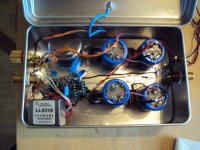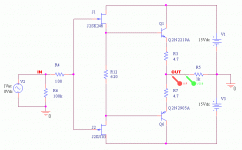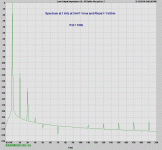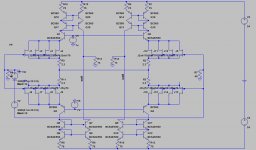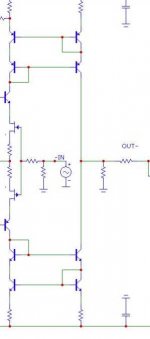Thanks Brian. It feels very good that you apreciate my work. I also made a transformer coupled inductive RIAA. The coil is made by Sowter to my spec and the input transformer is the most interesting Lundahl model. It uses an amorphous cobalt core and allows a lot of different configurations. I use 1:10 but for your IO 1:20 whould be perfect. I think that is the only way to low noise with such an exotic cart that drops only 0.025mV. This stage is soundwise tough competion even for my best commercial stages. This inductive priciple gives a midrange openness and enyoyment factor that is downright adictive. I drive it with 12V high power lead acid batteries.
Lundahl makes even two more expensive models but they do not have the flexibility of this one and i am not prepared to pay a premium for Cardas wire. Sowter makes good stuff too and they use MU Metal core. I have not heard a Sowter trasformer in my home but the coil they make for me has a Mu Metal core too and performs a wounderfull job.
Lundahl makes even two more expensive models but they do not have the flexibility of this one and i am not prepared to pay a premium for Cardas wire. Sowter makes good stuff too and they use MU Metal core. I have not heard a Sowter trasformer in my home but the coil they make for me has a Mu Metal core too and performs a wounderfull job.
Attachments
Thanks Brian. It feels very good that you apreciate my work. I also made a transformer coupled inductive RIAA. The coil is made by Sowter to my spec and the input transformer is the most interesting Lundahl model. It uses an amorphous cobalt core and allows a lot of different configurations. I use 1:10 but for your IO 1:20 whould be perfect. I think that is the only way to low noise with such an exotic cart that drops only 0.025mV. This stage is soundwise tough competion even for my best commercial stages. This inductive priciple gives a midrange openness and enyoyment factor that is downright adictive. I drive it with 12V high power lead acid batteries.
Lundahl makes even two more expensive models but they do not have the flexibility of this one and i am not prepared to pay a premium for Cardas wire. Sowter makes good stuff too and they use MU Metal core. I have not heard a Sowter trasformer in my home but the coil they make for me has a Mu Metal core too and performs a wounderfull job.
This is the one for me! I have still to finish the poweramp + buffer!
As you know I have a pair of new speakers......these are the "Director's Cut"
version of a top designers work and are now burning in nicely. My two slate plinth TTs - a just re-built (by Vantage Audio) SP10 Mk2 and a totally overhauled Lenco with a lot of chassis changes - are rearing to go! I have also got to have a few new pieces made for my new tonearm, but most machinists hate working with carbon.
Well get it all done by the end of the year.......... I hope! Anyone need four Siemens V72 tube mic amps? Selling these will speed progress!
Hy Brianco, you are a very bussy man like me. I wish you succes. Maybe you should try my new buffer instead of the JLH. I will make a version that works in the circuit you use.
Jam, the resistor and the cap have the purpose that the drain current is shortcircuited to ground. Maybe you can explain what happens then. Think about Miller Effect.
Your buffer is a simpified version of mine and sounds great too with minimum hastle. Interesting that you chose the same high Pinsh Off Voltage Fets i use. That is the only way to bias the output trannies correctly. The voltage reference has a very low dynamic impedance thus driving the bases with low impedance increasing speed and lowering distortion. The trimmer provides DC Offset cancelation and gives a measure of feedback thus lowering second and forth by 6dB. You can connect the middle tab to ground and then the buffer is fully open loop when you do not count current feedback.
Now you get a nicely stagggered 2nd, 3rd, 4th, 5th etc exponentially falling. A switch could be implemented and the you can show your friend how NFB affects the sound. By the way in any connection THD is superbly low and flat to 100kHz. This liitle animal is much more inteligent as many may think.
Jam, the resistor and the cap have the purpose that the drain current is shortcircuited to ground. Maybe you can explain what happens then. Think about Miller Effect.
Your buffer is a simpified version of mine and sounds great too with minimum hastle. Interesting that you chose the same high Pinsh Off Voltage Fets i use. That is the only way to bias the output trannies correctly. The voltage reference has a very low dynamic impedance thus driving the bases with low impedance increasing speed and lowering distortion. The trimmer provides DC Offset cancelation and gives a measure of feedback thus lowering second and forth by 6dB. You can connect the middle tab to ground and then the buffer is fully open loop when you do not count current feedback.
Now you get a nicely stagggered 2nd, 3rd, 4th, 5th etc exponentially falling. A switch could be implemented and the you can show your friend how NFB affects the sound. By the way in any connection THD is superbly low and flat to 100kHz. This liitle animal is much more inteligent as many may think.
I just simulated a balanced transimpedance-transconductance version based on your l'art du son circuit. It is now a diff amp. I think I know now where to spend my last 16 2sk389/2sj109 chips! Super low distortion, low noise. It is more or less a ugs module without loop feedback, your CS-arrangement and 4x4 Fets!
Rüdiger
Rüdiger
sounds like it may be a little similar to the stuff charles hansen of ayre does?
mlloyd1
mlloyd1
I just simulated a balanced transimpedance-transconductance version based on your l'art du son circuit. It is now a diff amp. I think I know now where to spend my last 16 2sk389/2sj109 chips! Super low distortion, low noise. It is more or less a ugs module without loop feedback, your CS-arrangement and 4x4 Fets!
Rüdiger
Jam and Rüdiger, yes the mirror can be anhanced but be carefull to make it not too high in output impedance or you can build a Teremin by waving your hand over it. Cool adoption by the way. Do you do the RIAA then double too ? If you do that components have to be well matched in the negative and positive side or you can get cancelation or anhancement over the frequency range.
My Plan is to build this module and try different options for the riaa network. I guess the most elegant way would be to make a 'swimming' network, clamped between out1 and out2 ( the values for the resistors half, and for the caps double, but no matching troubles). I need a balanced to SE converter as well and will try a ugs as a 2nd stage with SE output. I will try with buffers as well.
Rüdiger
Rüdiger
